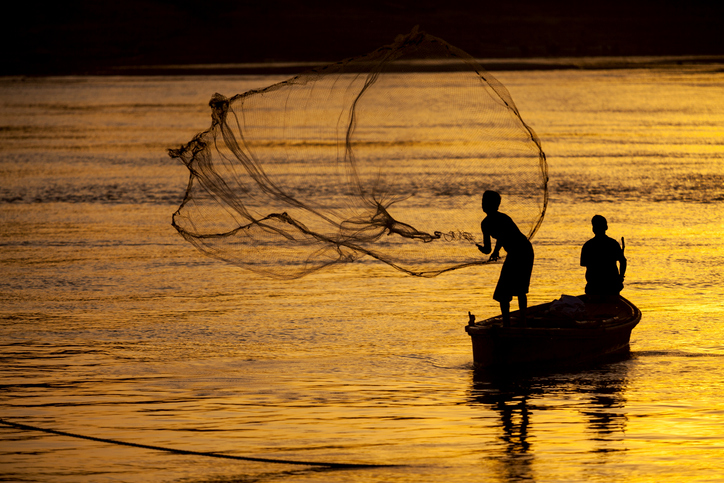India’s fisheries sector has witnessed remarkable growth over the past decade, with total fish production surging by 104 per cent from 96 lakh tonnes in 2013-14 to 195 lakh tonnes in 2024-25, according to the latest data from the Department of Fisheries. This expansion, particularly in inland fisheries which grew by 142 per cent to 147.37 lakh tonnes, underscores the country’s emergence as the world’s second-largest fish producer, contributing around 8 per cent to global output.
The sector, a vital source of food, employment and income for millions in coastal and rural areas, has been transformed through modern aquaculture practices, improved infrastructure and government schemes. A standout example is Navkishar Gope, a displaced villager from Jharkhand’s Gangudih Punarwas who started with nothing but turned his life around through cage culture under the Pradhan Mantri Matsya Sampada Yojana (PMMSY). With training and financial aid, he boosted his production, reduced fish mortality and now owns a house and a moped, dreaming of further expansion.
This growth reflects a shift towards sustainable, high-yield methods, bolstered by investments in hatcheries, pond systems, cold chains and market networks. The Union Budget for 2025-26 has allocated a record Rs 2,703.67 crore for the sector, the highest ever, to sustain this momentum.
The journey began with the Blue Revolution in 2015, aimed at enhancing productivity and infrastructure in marine and inland fisheries. However, gaps in post-harvest handling, traceability and fisher welfare persisted, leading to the launch of PMMSY in 2020. With a total outlay of Rs 20,050 crore over five years (extended to 2025-26), the scheme has approved projects worth Rs 21,274.16 crore as of July 22, 2025, including a central share of Rs 9,189.79 crore. So far, Rs 5,587.57 crore has been released, generating direct and indirect jobs in fishing, aquaculture, processing and marketing.
Under PMMSY, the government has also greenlit the formation of 200 existing fisheries cooperatives into Fish Farmer Producer Organisations (FFPOs) and 195 new ones as of July 29, 2025. Infrastructure projects total Rs 17,210.46 crore, with Rs 6,761.80 crore from the Centre. Notable developments include 34 notified fisheries clusters, including organic ones in Sikkim and Meghalaya, and 11 integrated aquaparks costing Rs 682.60 crore. These hubs provide end-to-end support from seed and feed to processing and markets, reducing losses and boosting farmer incomes.
Innovation is a key pillar, with 39 startups receiving Rs 31.22 crore in subsidies for seed funding and incubation. In FY 2025-26, 163 new projects worth Rs 6,273.31 crore have been approved, including Rs 4,209.05 crore for interest subvention.
Complementing PMMSY is the Pradhan Mantri Matsya Kisan Samridhi Sah-Yojana (PM-MKSSY), a Rs 6,000 crore sub-scheme launched in February 2024, running till 2026-27. It focuses on formalisation, insurance, finance access and quality assurance, with Rs 11.84 crore already sanctioned by April 2025.
The National Fisheries Digital Platform (NFDP), launched in September 2024 under PM-MKSSY, has registered over 26 lakh stakeholders by August 2025, offering digital identities, credit access, insurance and training via a single portal (nfdp.dof.gov.in).
Financial inclusion has been amplified through the Fisheries and Aquaculture Infrastructure Development Fund (FIDF), extended till March 2026 with a Rs 7,522.48 crore corpus. It provides credit guarantees up to Rs 12.50 crore and 3 per cent interest subvention. The Kisan Credit Card scheme, now with a raised limit of Rs 5 lakh for fisheries, has issued 4.76 lakh cards by June 2025, disbursing Rs 3,214.32 crore.
Tribal upliftment is integrated via the Dharti Aaba Janjatiya Gram Utkarsh Abhiyan, extending fish culture support to 10,000 groups and 1 lakh individuals with Rs 375 crore allocation under PMMSY.
Technological advancements include Recirculatory Aquaculture Systems (RAS) and Biofloc, with 12,000 RAS units (Rs 902.97 crore total cost) and 4,205 Biofloc units (Rs 523.30 crore) approved by March 2025. These promote water-efficient, high-density farming.
Infrastructure modernisation features three smart fishing harbours in Diu, Puducherry and Gujarat (Rs 369.8 crore), equipped with AI, IoT, solar power and eco-friendly systems, aligning with FAO’s Blue Port Initiative. International ties include FAO collaborations and workshops with the French Development Bank.
Inclusivity is evident in higher aid for Scheduled Castes, Tribes and women, with Rs 3,973.14 crore in women-related projects approved. PM-MKSSY also aids micro-enterprises with World Bank and AFD funding.










